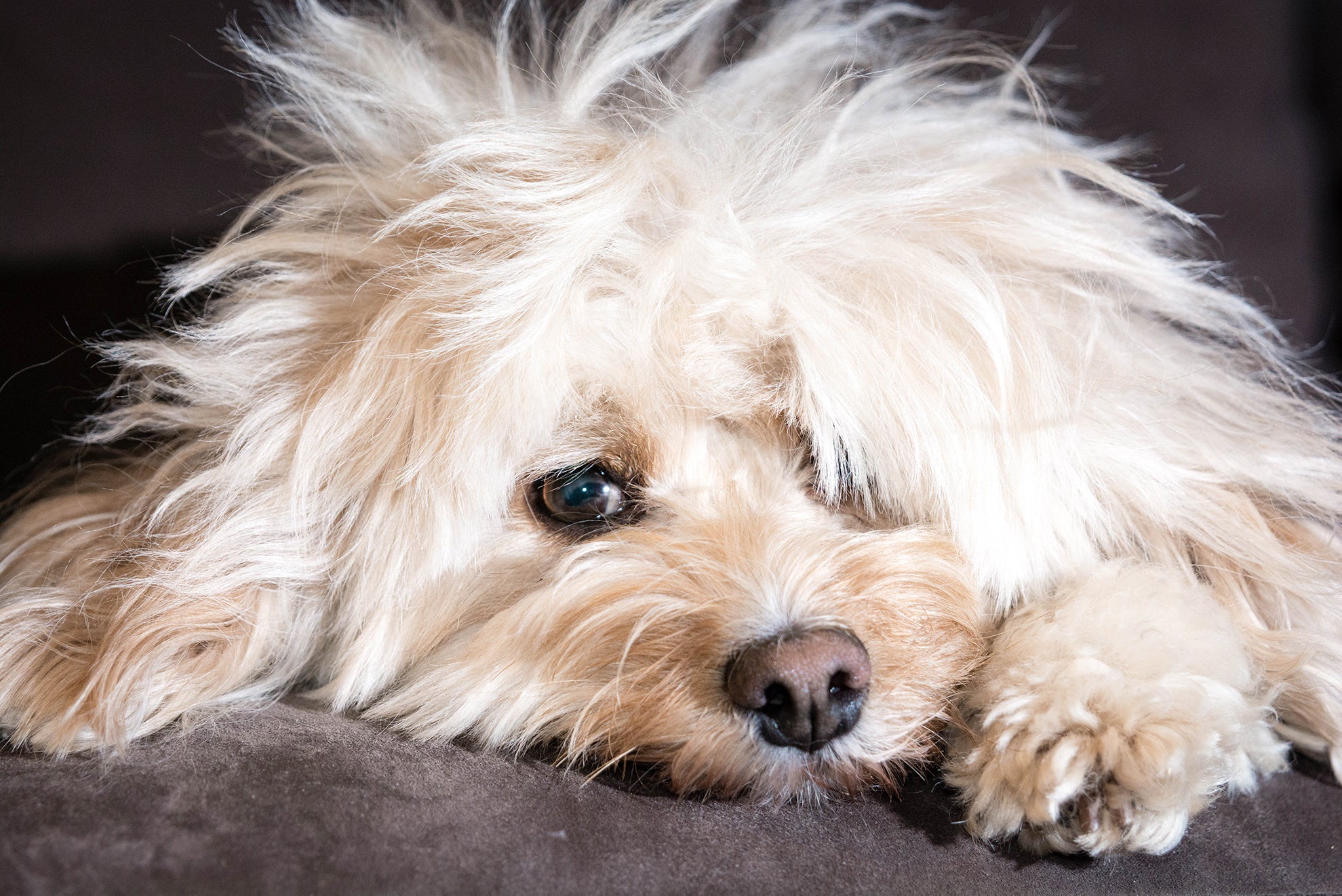The long-term wellbeing of your best friend
It can be disheartening watching your elderly dog struggle to use his hind and front legs. Well, you can’t believe your once energetic dog who would romp all over the yard now is reluctant to play. However, don’t despair, there are various interventions as a dog owner that you can easily apply in order to help strengthen your elderly dog’s hind legs. At some point, you may need to combine various tactics so that your dog’s hind legs become stable and strong. Sounds good? Before learning how to strengthen an old dog's hind legs, here are the major causes of leg weakness in elderly dogs.

What Causes Sudden Hind Legs Problems in Old Dogs?
A host of disorders might affect how your old dog uses his hind legs. Some are painful, and some cause no discomfort to your dog. However, the main concern about these conditions is that they hamper your old dogs' quality and quantity of life.

Osteoarthritis
Osteoarthritis is the leading cause of hind leg problems in elderly dogs. According to the American Kennel Club (AKC) osteoarthritis is a degenerative joint disease that occurs when cartilages become inflamed due to wear and tear. Normally the cartilages ensure your dog's joints are well cushioned and don't grind on each other. However, with constant wear and tear due to usage, the cartilages inflame and limit how your dog moves around.
Hip Dysplasia
Hip dysplasia is another joint problem that might cause your old dog to lose the functionality of his hind leg. This chronic condition occurs when the hip joint ball and socket don't align. Instead of fitting smoothly in the socket, the hip joint ball rubs on the surface, which causes severe pain. If the rubbing is not controlled, there might be loss of the cushioning cartilages leading to osteoarthritis. Moreover, this condition is predominant in large breeds like the German Shepherd, the Great Dane, and Saint Bernard. Besides being painful, your dog's knee joint may become stiff. Also, while your dog is moving, you might hear a grating sound around the joint.
Canine Degenerative Myelopathy
Canine degenerative myelopathy or chronic degenerative radiculomyelopathy is a neurodegenerative disease that makes your elderly dog hind legs collapse. Unlike other joint problems, a dog suffering from degenerative myelopathy experiences no pain. Nevertheless, such an elderly dog may have wobbly movement. Still, this dog easily falls even with the slightest of touches.
Cruciate Ligament Tear
A tear of the cruciate ligament can affect how your elderly dog uses his hind legs. This condition is painful and, if not attended to, just might cripple your dog.
Intervertebral Disc Disease
Abbreviated as IVDD, this condition occurs when the cartilage disc cushioning your old dog's backbone gets displaced, thus applying pressure on your dog's spinal cord. A dog suffering from IVDD may develop wobbly movement, partial paralysis, and weakened hind legs.

Symptoms of Hind Leg Problems in Old Dogs
The main root cause will determine which symptoms your old dog with hind legs problems may present be sure to consult your veterinarian. Most importantly, managing to spot these symptoms early will be crucial. Again, with your vet's advice, you can structure how you can help strengthen an old dog's hind legs for improved mobility.
Watch out for these symptoms:
- Limping
- Reluctance to stand up
- Walking slowly
- Favoring a certain limb over the other
- Irritability
- Wobbly movement
- Lack of enjoyment in activities your dog previously liked
- Whimpering if in severe pain
- Dragging of the hind legs
- Abnormal gait
How to Strengthen an Old Dog's Hind Legs
The vet's diagnosis will be crucial as you prepare various treatment plans or interventions to strengthen an old dog's hind legs. That is why working with your vet will be essential as you start this journey of making your elderly dog comfortable and happy. With that said, there are various effective natural interventions combined with prescribed medication that can see your elderly dog's hind leg functionality improve with time. And, as stated earlier some of these beneficial interventions include nutraceuticals in the form of clinically formulated and tested dietary supplements.
Supplements Will Help Strengthen Old Dog Hind Legs
Joint supplements for dogs are becoming popular in the canine world as most dog owners see their benefits. Most vets and canine nutritionists recommend that you give your dog with joint or bone problems supplements enriched with glucosamine and chondroitin.
This glucosamine and chondroitin combination rebuilds worn-out cartilages, reduces inflammation, promotes flexibility, and soothes those painful joints. Our Earthgenics™ Joint Health supplements contain the precise combination of glucosamine and chondroitin, which will be critical in strengthening your old dog's collapsing hind legs. Besides that, these natural joint health supplements are enriched with Omega 3 and 6 fatty acids sourced from fish oil and flaxseed. It is important to note, that these fatty acids reduce inflammation that might hamper your dog's usage of his hind legs. Additionally, the included vitamin C in this joint supplement helps produce the much-needed collagen that keeps your dog's bones intact.

Exercise Will Be Crucial
Exercising can help strengthen an old dog’s hind legs with time. However, before exercising your dog, ensure it’s not at all in severe pain. Also, as a major caution, avoid over-exerting your old dog, as you might aggravate the already severe problem. Now, when it's time to exercise your elderly dog, things to consider:
- Short Walk Sessions - besides keeping your dog fit, short walk sessions will strengthen those muscles on the hind legs. Try walking your dog in hilly areas. This way, the inclination will invite your dog to use his frail hind legs. And, do it 3 to 4 times a week consistently and watch your dog's mobility improve.
- Swimming Sessions - Swimming is a low-exerting exercise that can help strengthen an old dog’s hind legs. Swimming will allow your dog to use his weak hind legs muscles without putting excess pressure on the joints. When swimming, watch how your dog reacts and in case he seems to struggle, then immediately pull him out of the water.
- Practice “sit” and “stand” commands with your dog. Well, we know your dog is conversant with these commands. However, practicing them will help strengthen muscles all over the hind legs.Walking on a mattress will help strengthen an elderly dog's hind legs. If your dog is not a fan of climbing hills or swimming, walking or exercising on a mattress can help. The bouncy nature of the mattress ensures your dog uses all of his limbs, more so the hind legs.
Weight Management
There's nothing worse than having an obese dog with hind legs problems– it's disastrous and could shorten your dog's quality of life and the period of life itself. More significantly, this excess weight can put lots of pressure on the hind legs, thus hindering his overall movement.
A quick and simple method to check whether your dog is obese, run your fingers across his ribs. If your dog is at an ideal weight, you should feel the ribs with ease, but they shouldn’t be invisible. However, an obese dog will have a thick layer of fat covering the ribs. If your dog seems overweight, then a vet's advice on ways you can reduce your furry friend's weight during this time will be crucial.
The Right Diet Will Be Key
Feeding your dog with a poorly balanced diet will cause more harm than benefit. With that said, if you want to strengthen an old dog's hind legs, look for a diet tailored for that work. The best diet should have high-quality protein from animal sources. The protein in your dog's diet will enhance calcium absorption, leading to strengthened hind legs. Instead of feeding your dog with high calorific treats, opt for healthier snacks like baby carrots or slices of pineapple.
Non-Steroidal Anti-inflammatory Drugs (NSAIDs)
Non-steroidal anti-inflammatory drugs will not help strengthen an old dog's hind legs but will help relieve your dog from inflammation and pain. Yet, before administering NSAIDs consult your vet. And, make sure to ask him about the best NSAIDS that your elderly dog with severe pain can take while minimizing adverse side effects.
Acupuncture Will Help Strengthen an Old Dog’s Hind Legs
There are some vets who have begun to offer and perform acupuncture. With that, you can inquire from your vet whether such therapy will help strengthen your elderly dog's hind legs. The main purpose of acupuncture is to awaken or stimulate your dog's natural healing abilities. In short, the vet places needles on your dog's pressure points all in an effort to increase blood flow and nerve transmission to the ailing parts.

Change Your Dog's Environment
The above tips on strengthening your old dog's hind legs will be crucial if you want your senior dog to enjoy his golden years happily. Here are other ways to make your dog's recovery from hind leg problems comfortable and painless.
- Put down rubber mats or non-slippery rugs on slippery floors. Thus, making it easier for your dog to move around safely around the floor. This will ensure your dog won't skid and worsen his joint issues.
- Get stairs or ramps - with that, you can make it easier for your dog by getting ramps or stairs for easier access to raised platforms. And, no jumping up and down on the couch as you might see your dog's hind legs problems worsen with time.
- Get your dog a comfortable bed - no need to let your dog sleep on a cold floor. More so, when old age hits, sleeping on a hard floor can take a toll on its weak hind legs. The good thing is that there are specialized foam beds that your dog can sleep on and wake up with its sore muscles and bones soothed.

Final Thoughts
There is no need to worry now that your elderly dog seems to lose the functionality of his hind legs. There is a ray of hope if you follow the highlighted tips on strengthening an old dog's hind legs. Also, remember to include your family members in your set plans of making your elderly dog comfortable. After investing your time and being patient, consistent, and following your vet's advice with time, your elderly dog might regain the full functionality of his hind legs.




